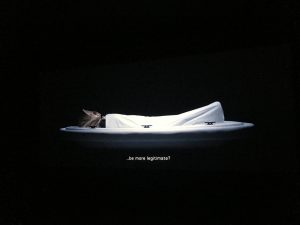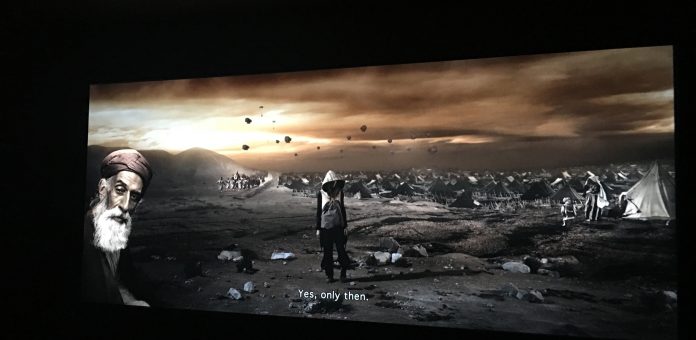(THIS ARTICLE IS MACHINE TRANSLATED by Google from Norwegian)
I'm in London with my son, 13. It's sunny and 30 degrees in the shade, and he (in the 'I-don't-know-what' phase) does not know what he wants, so I, 42, suggest a sci-fi show. at the art center The Barbican. He hesitates. But there are costumes there from Star Trek and Star Wars and Interstellar, I say, and you can play Darth Vader's theme song on saxophone, and… "Okay," says 13, and we go from Shoreditch through Paul Street to Wilson Street. . He has orange shoes and red sunglasses, it looks like he is part of the exhibition in the monumental brutalist complex Barbican Center – currently occupied by something reminiscent of a magnificent catalog with tastings from sci-fi history. We follow the evolution from virtual attempts to travel to the center of the Earth, to when man lifts his head and occupies the airspace with hot air balloons – and eventually rockets and spaceships in star wars over extraterrestrial territories. Here are excerpts from books, games, comics and music. And movie clips that flicker across screens in ceilings and on walls.
 Relics. There are the drawings of Jules Verne, from the preparation of his classic books Earth Around Eighty Days and the Journey to the Earth's Inner. There is Laura Dern's famous facial expression from Jurassic Park as she sees a brachiosaurus for the first time. And there, in the very heart of the exhibition, is Darth Vader's mask. Everything becomes more true or real because we can almost touch it – like relics. But what is it about sci-fi that is so exciting or important? 13 believes that the answer lies in the meeting between humans and the stranger – animals that do not exist, for example – and what happens then. The exhibition also thematizes the treatment of the alien and extraterrestrial in fiction, and how it can reflect our encounters with the alien in reality.
Relics. There are the drawings of Jules Verne, from the preparation of his classic books Earth Around Eighty Days and the Journey to the Earth's Inner. There is Laura Dern's famous facial expression from Jurassic Park as she sees a brachiosaurus for the first time. And there, in the very heart of the exhibition, is Darth Vader's mask. Everything becomes more true or real because we can almost touch it – like relics. But what is it about sci-fi that is so exciting or important? 13 believes that the answer lies in the meeting between humans and the stranger – animals that do not exist, for example – and what happens then. The exhibition also thematizes the treatment of the alien and extraterrestrial in fiction, and how it can reflect our encounters with the alien in reality.
Are we in the past, future or present? Maybe all at once.
With counterfactual stories, "what-if-scenarios" can be tested. Pierre-Jean Giloux's 1 film Invisible Cities Part 2015 is an homage to the 60s metabolists. They developed organic architecture designed for Tokyo, and these unrealized projects are manipulated into film footage of today's Tokyo using 3D. The buildings are similar to trees and can be seen from different corners of the city, between skyscrapers and behind bridges. They are integrated into the existing, along with a sound image, as if someone lives there. And there is a constant snow of cherry blossoms falling over the city, even though there are no trees so high up. A reminder, perhaps, of the metabolists' views of sustainable cities. Finally, the night also falls over the city.
In one of the exhibition's few works created by a woman, Larissa Sansour's film In the Future They Ate From the Finest Porcelain from 2015, narrative terrorism is pursued: Spacecraft in a dark horizon drops bombs on a desert landscape. As the bombs open, porcelain plates with the keffiyeh motif are known from the Palestinian scarves. They are sent from a fictional civilization to be buried in the earth as evidence of their existence. A salute to future archaeologists. Are we in the past, future or present? Maybe all at once.
 Sci-fi future. 13 says he hopes the Earth will not be destroyed until he dies. We are heading back to the hotel. There are cars on all sides. The constant noise. The planes in the sky. Dressed from the Pride Parade on sidewalks and buses – it's been 50 years since Britain decriminalized homosexuality. "You can move to Mars," I jokingly, thinking of all the films about traveling to the stranger, something should be better. The result is often worse than one can imagine. I try to say something about everything that is environmentally friendly that can be found, all the technology we have, that he has to become an inventor and create a smart solution, but I talk too fast, the pace reveals me. I would ask if he thinks much about this, but we have messed with the road. I can remind him of what has happened in his life up until now, from when he was little. And sometimes I revise the stories, think of something, if I don't remember what happened. But the future? Everything I say sticks in him somewhere.
Sci-fi future. 13 says he hopes the Earth will not be destroyed until he dies. We are heading back to the hotel. There are cars on all sides. The constant noise. The planes in the sky. Dressed from the Pride Parade on sidewalks and buses – it's been 50 years since Britain decriminalized homosexuality. "You can move to Mars," I jokingly, thinking of all the films about traveling to the stranger, something should be better. The result is often worse than one can imagine. I try to say something about everything that is environmentally friendly that can be found, all the technology we have, that he has to become an inventor and create a smart solution, but I talk too fast, the pace reveals me. I would ask if he thinks much about this, but we have messed with the road. I can remind him of what has happened in his life up until now, from when he was little. And sometimes I revise the stories, think of something, if I don't remember what happened. But the future? Everything I say sticks in him somewhere.
We are hot, thirsty. Then he recognizes a tag he has seen before and I a sign. I suggest takeout and film in the hotel room, where the furniture is screwed on – just like in a spaceship. The window cannot be opened, but there are blinds in which can be controlled from an iPad, and the temperature and light can be set in different modes: romantic, relaxing, workmode, party, low, medium, intense – because here too everything sci-fi belongs -estetikken; the architecture, the things, the colors, the futuristic expression. And I think that even the sci-fi vocabulary, with words like extraordinary, outer, space, new, unknown, is just as incorporated into our reality as Freud and surrealism. Like driving a car.
My son says he hopes the Earth is not destroyed until he dies.
But 13, he is the stranger to me now, the body, the language and the references – if I do not follow. At night he falls asleep, and I think he disappears, into puberty, into the body that gives rise to pains and pimples, into choices, lethargy, Bowmasters and FIFA, and in everything I don't know – because it's important with secret rooms, everyone understands that. And in the morning I wake up early and wander around, like an old lady, a dinosaur, a 42. So I go for a walk. And it is only then that it dawns on me, of course, that it is only I who experiences that he disappears. He is traveling, he; living, breathing, eating, drinking, sleeping, growing. And watching youtube videos.
When I'm back at the hotel for breakfast, he asks me for help with the hair wash, and I wash his hair, maybe for the last time, I splash water on him, we laugh. A few hours later he will board a bus to Shaftesbury. The sun is going to be low and his shadow long, and not until late at night will I get a message: “I'm fine. PS! You don't have to call for a while. Send mail. »


